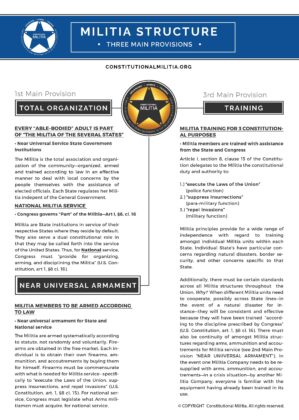Last Updated on January 15, 2023 by Constitutional Militia
Militia Structure— 1st Main Provision
TOTAL ORGANIZATION: Every “able-bodied” adult is part of “the Militia of the several States” pursuant to CONSTITUTIONAL PROVISION AND STATE STATUTE
1st Main Provision of the Militia Structure: Every “Able-bodied” adult is part of it.
The Militia structure is highly organized (i.e., every “able-bodied” adult is part of it)—the exact opposite of what we presently have in the United States, which is atomized individuals, or individuals in very small groups disconnected from the rest of society with no constitutional legal authority. Militia are State government institutions, organized under State statute, thoroughly civilian in character. The Militia Structure is largely outside the jurisdiction of the General Government (what many people mistakenly refer to today as the “Federal” government). WE THE PEOPLE refused to entrust “the security of a free State” (Second Amendment) to a transient Political Class, but influence and enforce “a free State” ourselves by serving in “[a] well regulated Militia” (Second Amendment), which is constitutional “homeland security” based upon the right of the people to keep and bear arms. “[T]he Militia of the several States” is the only institution to which the Constitution guarantees will always “keep and bear Arms” (Second Amendment) because it is the sole institution “necessary to the security of a free State” (Second Amendment).
Constitutionally, The Power of the Sword is broken up into three parts at the level of the General Government:
1.) Army
2.) Navy
3.) Militia
The Constitution recognized the Militia as preexisting and settled them as State government institutions. The Militia institution is as permanent as Congress, the President, and the Supreme Court. Militia Structures empower average Americans to govern themselves with full legal authority and to provide themselves with security from any and all threats. “A well regulated Militia” (Second Amendment) is a lawful check against rogue government officials who try to unconstitutionally expand their authority by violating the Constitution under color of law.
That it was Rhode Island’s practice, from the early to the late 1700s, to require Militia service, not just from her permanent residents, but also from mere “transient persons”, evidences the near-universality and seriousness of the duty.[1]






























